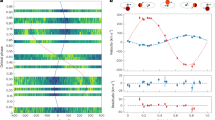Abstract
We have discovered that the white dwarf star Giclas 29 – 38 appears to emit substantial radiation at wavelengths between 2 and 5 μm, far in excess of that expected from an extrapolation of the visual and near-infrared spectrum of the star. The infrared colour temperature of the excess radiation is 1,200±200 K and, at the distance of G29 – 38, corresponds to a total luminosity of 5 × 10−5 solar luminosities (L⊙). If the excess 3.5-μm radiation is emitted by a single spherical body at 1,200 K, then its radius is 0.15 solar radii (R⊙). These characteristics are similar to those that have been calculated for substellar objects called brown dwarfs. The most natural interpretation of our observations is that there is a substellar, somewhat Jupiter-like brown dwarf in orbit around G29–38.
This is a preview of subscription content, access via your institution
Access options
Subscribe to this journal
Receive 51 print issues and online access
$199.00 per year
only $3.90 per issue
Buy this article
- Purchase on Springer Link
- Instant access to full article PDF
Prices may be subject to local taxes which are calculated during checkout
Similar content being viewed by others
References
1. Liebert, J. & Probst, R. G. A Rev. Astr. Astrophys. 25, 473-519 (1987). 2. Probst, R. G. & Liebert, J. Astrophys. J. 274, 245-251 (1983). 3. Zuckerman, B. & Beckiin, E. E. Astrophys. J. 319, L99-L102 (1987). 4. Sion, E. M. et al. Astrophys. J. 269, 253-257 (1983). 5. Probst, R. G. Astrophys. J. Suppl. 53, 335-349 (1983). 6. Greenstein, J. L. Astrophys. J. 276, 602-620 (1984). 7. Shulov, O. S. & Kopatskaya, E. N. Astrofizika (SSR) 10, 117-119 (1973). 8. McGraw, J. T. & Robinson, E. L. Astrophys. J. 200, L89-L93 (1975). 9. Holm, A. V. et al. Astrophys. J. 289, 774-781 (1985). 10. Aumann, H. H. et al. Astrophys. J. 278, L23-L27 (1984). 11. Wyatt, S. P. & Whipple, F. L. Astrophys. J. Ill, 134-141 (1950). 12. Alcock, C., Fristrom, C. C. & Siegelman, R. Atrophys. J. 302, 462-476 (1986). 13. Bruhweiler, F. C. & Kondo, Y. Astrophys. J. 269, 657-667 (1983). 14. Delsemme, A. H. in Comets (ed. Wilkening, L. L. ) 85-230 (University of Arizona, Tucson, 1982). 15. Nelson, L. A., Rappaport, S. A. & Joss, P. C. Astrophys. J. 311, 226-240 (1986). 16. Iben, I. & Tutukov, A. V. Astrophys. J. 282, 615-630 (1984). 17. Mazzitelli, I. & D'Antona, F. Astrophys. J. 308, 706-720 (1986). 18. Harrington, R. S. & Dahn, C. C. Astr. J. 85, 454-465 (1980). 19. Berriman, G. & Reid, N. Mon. Not. R. astr. Soc. 227, 315-329 (1987). 20. Livio, M. & Soker, N. Mon. Not. R. astr. Soc. 208, 763-781 (1984).
Author information
Authors and Affiliations
Rights and permissions
About this article
Cite this article
Zuckerman, B., Becklin, E. Excess infrared radiation from a white dwarf—an orbiting brown dwarf?. Nature 330, 138–140 (1987). https://doi.org/10.1038/330138a0
Received:
Accepted:
Issue Date:
DOI: https://doi.org/10.1038/330138a0
This article is cited by
-
Instability of Triangular Equilibrium Points in the Restricted Three-Body Problem Under Effects of Circumbinary Disc, Radiation Pressure and P–R Drag
Earth, Moon, and Planets (2022)
-
Spitzer’s debris disk legacy from main-sequence stars to white dwarfs
Nature Astronomy (2020)
-
Accretion of a giant planet onto a white dwarf star
Nature (2019)
-
Stability analysis of triangular equilibrium points in restricted three-body problem under effects of circumbinary disc, radiation and drag forces
Journal of Astrophysics and Astronomy (2019)
-
A disintegrating minor planet transiting a white dwarf
Nature (2015)
Comments
By submitting a comment you agree to abide by our Terms and Community Guidelines. If you find something abusive or that does not comply with our terms or guidelines please flag it as inappropriate.



